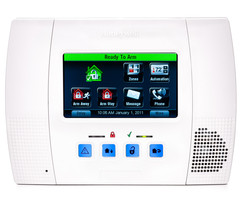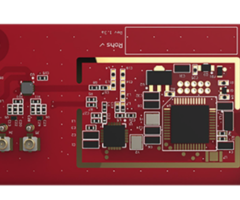How Do I Upgrade My Honeywell L5100 to a Honeywell PROA7PLUS?
You can upgrade your Honeywell L5100 to a Honeywell PROA7PLUS by installing a Honeywell Home PROTAKEOVER inside of the PROA7PLUS and then enrolling the old sensors from the L5100 with the new PROA7PLUS Alarm Panel. The majority of the sensors from the L5100 can be used with the new system.

The sensors used with the Honeywell L5100 Security System are 345 MHz sensors called Honeywell 5800 Series Sensors. There may also be various third party devices operating at the 345 MHz frequency that are also used with the L5100. But in any case, the L5100 only accepts Honeywell 5800 Sensors and third party sensors that can communicate at that exact same 345 MHz frequency. The Honeywell PROTAKEOVER Module is a wireless receiver add-on for the PROA7PLUS that allows the system to accept one (1) of five (5) available legacy wireless frequencies. By setting the dial on the PROTAKEOVER Module to 0, the unit will listen for the Honeywell 5800 Series 345 MHz frequency. You will then be able to pair your old L5100 sensors with your new PROA7PLUS System.
If you still need to purchase a PROA7PLUS Alarm System AND a PROTAKEOVER Converter Module, then we strongly recommend purchasing one of the bundled kits listed below. Each kit includes a PROA7PLUS Panel, a PROTAKEOVER Module, and a Honeywell LT-Cable for providing power. The difference between each kit is its included communicator options. One kit is WIFI only, while the other two are dual-path with both IP and LTE cellular. You can choose between AT&T and Verizon if you opt for a dual-path kit. This has nothing to do with your personal phone provider, and you should decide based on which network provides better service in the area where the system will be used. Check coverage maps if you are unsure. Keep in mind that you will need a monitoring plan that includes cellular connectivity if you decide to go dual-path.
PROA7PLUS RF Takeover Kits
| Kit Name | SKU | Communicator Type |
|---|---|---|
| Honeywell Home PROA7PLUSWLTAKE | PROA7PLUSWLTAKE | Built-in WIFI Communicator |
| Honeywell Home PROA7PLUSWLTAKEA | PROA7PLUSWLTAKEA | Built-in WIFI Communicator AT&T LTE Communicator |
| Honeywell Home PROA7PLUSWLTAKEV | PROA7PLUSWLTAKEV | Built-in WIFI Communicator Verizon LTE Communicator |
However, there are some restrictions on using Honeywell 5800 Sensors with a PROA7PLUS and a PROTAKEOVER Module. For one, only uni-directional Honeywell 5800 Sensors can be used with the setup. By "uni-directional", we mean sensors that use one-way communication and only send out wireless signals, without receiving any back. This is opposed to bi-directional sensors that use two-way communication. Any Honeywell 5800 Sensor that requires a House ID Setting is bi-directional and cannot interface with a PROA7PLUS and PROTAKEOVER Module combination. Examples of Honeywell 5800 Sensors that fit this bill include the Honeywell 5828 Keypad, the Honeywell 5800RL Relay, and the Honeywell 5800WAVE Siren.
Second, you cannot use any Honeywell 5800 Series Life-Safety Sensors with the PROA7PLUS and PROTAKEOVER Module. This means no smoke detectors, heat detectors, or carbon monoxide (CO) sensors. Also incompatible are all key fob devices. You may want to check out the compatibility chart for the PROTAKEOVER Module. Anything not listed on that chart is not guaranteed to work. There are some questionable absences, including the Honeywell 5800MINI Door/Window Sensor and the Honeywell 5800C2W Wired to Wireless Converter. But anything not listed on there is not guaranteed to work.
Complete the following steps to upgrade to a PROA7PLUS from a Honeywell L5100:
1. Install the PROTAKEOVER. First you must install the PROTAKEOVER Module inside the PROA7PLUS. Power down the system if you haven't already. You can do this by unplugging the panel's AC transformer from the wall outlet and also disconnecting its backup battery. To access the backup battery, remove the panel's bottom set screw, and then pull the panel off its backplate. You can then find the battery pack, and unplug it from its connection port.
The PROTAKEOVER Module comes with a new backplate for the PROA7PLUS. You must use this new backplate, and you can no longer use the original one that came with the PROA7PLUS. This is because there is a special antenna inside the PROTAKEOVER backplate that is needed for the wireless receiver to function properly. There are two (2) metal prongs on the PROTAKEOVER Module that make direct contact with the antenna inside its include backplate. If this connection is not completed, then the PROTAKEOVER would not offer a useful wireless range. If you had the PROA7PLUS mounted on its original backplate, then you can dismount that one right now, and then install the new PROTAKEOVER backplate in the same spot.
With the PROA7PLUS off its backplate, flip the panel over so that you are facing its backside. When facing the back of the panel on the right-hand side, there should be a cover that you can pull off. Removing this cover will allow you to insert the PROTAKEOVER Module into the slot. Before you do this, make sure to set the dial on the module to 0 so that you can successfully enroll the Honeywell 5800 Sensors that were used with your Honeywell L5100 System.
When ready, slide the PROTAKEOVER Module into the slot. Make sure that it is nice and secure. There is a set screw you can also apply to keep it more secure. You will know that the PROTAKEOVER is properly seated because the hole for its set screw will line up properly with the hole in the panel plastic. After inserting the module, you can then reapply the side cover. Then restore system power by connecting the backup battery first, and then AC power second. Finish by mounting the PROA7PLUS on the new backplate that came with the PROTAKEOVER. If you get lost at any point, refer to the PROTAKEOVER Install Guide.
2. Enroll existing L5100 sensors. With the PROTAKEOVER installed, you can now enroll the Honeywell 5800 Sensors that were used with the L5100 System with the new PROA7PLUS. Remember that you can only use the uni-directional "one-way" sensors. As these are all non-encrypted devices, you can technically bring them over to the PROA7PLUS without first deleting or clearing them from the L5100. In fact, they can stay enrolled with the L5100 System if you wish. That is usually the easiest and most practical option.
At the time of this writing in March 2021, it is impossible to perform local programming at the PROA7PLUS Panel itself. Instead, all system programming must be done remotely by the user's alarm monitoring company. This includes enrolling new sensors with the system. As such, the system must be actively monitored before the existing L5100 sensors can be brought over.
If you are keeping your existing monitoring provider as you transition from the L5100 to the PROA7PLUS, then your monitoring company can most likely access your L5100 programming and use that to program your new PROA7PLUS zones. But if you are switching to a new monitoring company, or if your monitoring company is unable to access your L5100 programming information for whatever reason, then you will need to access the information locally at the L5100 Panel and provide it to your monitoring company so that they can program your PROA7PLUS System.
To access Zone Programming on your L5100, start from the main screen, and then choose Security > More> Tools > Installer Code (default is 4112) > Program > Zones. You can then click on any zone to highlight it, and then press the Edit button at the bottom to show its settings. For programming the PROA7PLUS, you must provide the Zone Number, Device Type, Response Type, Zone Description(s), Serial Number, and Loop Number for any sensor that is being reused with the system. Some users find it easiest to just take a picture of any relevant zone. You can use the back arrow in the upper-right corner to return to the zone list. Repeat the process for each programmed zone until you have all the information needed. You should organize the information in an easy-to-read document or spreadsheet so that your monitoring provider can easily program your new system. You can return to the main screen of the L5100 by repeatedly pressing the return arrow in the upper-right corner. Make sure to choose "Yes" when asked if you want to allow the installer to re-enter programming. Otherwise, you will become locked out.

Keep in mind that you cannot retain any L5100 sensor that uses bi-directional communication for use with the PROA7PLUS. You also cannot use life-safety sensors that were paired with the L5100, including any smoke detectors or CO detectors. Remember that the PROA7PLUS with PROTAKEOVER Module will support up to (123) legacy RF zones for Honeywell 5800 Sensors. This is more than enough room to bring over every compatible Honeywell 5800 Sensor from your L5100 System, as the L5100 only supports up to (63) zones. You can use any of the remaining legacy RF zones on your PROA7PLUS with additional Honeywell 5800 Sensors that you add later. In addition, the PROA7PLUS also has (127) encrypted zones for use with PROSIX Sensors and Honeywell SiX Sensors. The encrypted zones are separate from the legacy RF zones that the Honeywell 5800 Sensors use.

3. Test the system. Once all the sensors have been paired with your PROA7PLUS Alarm Panel, you should test the system to make sure that it is functioning properly. There is a test mode that you can access on the PROA7PLUS to perform a complete walk test. Access this mode by starting from the main system screen and choosing the three (3) horizontal bars button at the bottom, and then select Tools > enter the Installer Code (default 4112) > System Tests > Test Sensors. A list of all programmed sensors should appear. Click the Start Test button in the upper-right to begin. Then go through and fault (activate) each sensor that has been enrolled. You will know that the PROA7PLUS received the signal from a sensor because it will move from the bottom of the screen to the top and display in bold. Once you have finished activating every sensor, check the panel to make sure that every sensor was acknowledged. Remember to always put your system on Test Mode with the central station before performing a walk test like this, as you do not want to cause any false alarms.
Did you find this answer useful?
We offer alarm monitoring as low as $10 / month
Click Here to Learn MoreRelated Products


Related Categories
- Answered
